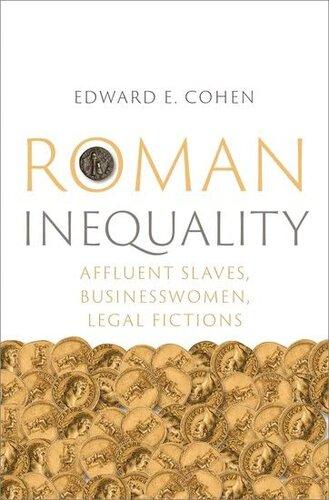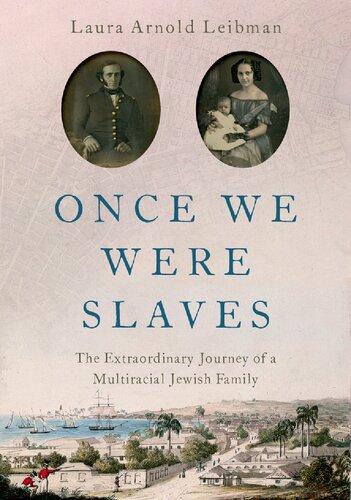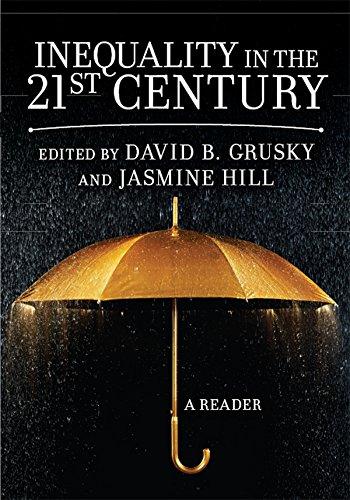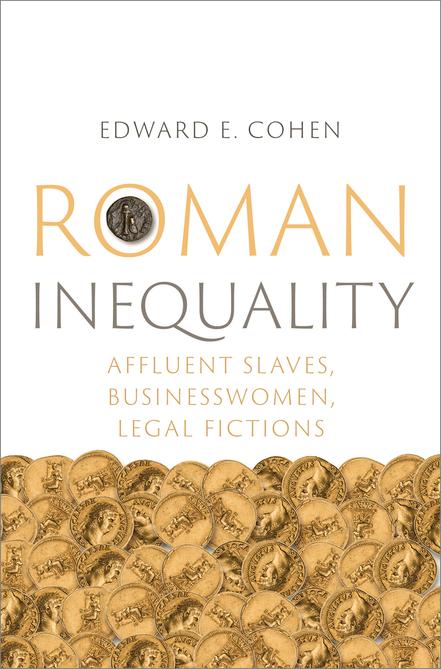Introduction
At Rome during the Early and High Empires, a scanty sliver of men and women in both the free and the slave populations—a tiny elite of affluent slaves and wealthy free persons—prospered amidst a mass of impoverished free inhabitants and of impecunious enslaved inhabitants,1 confirming that the legal status of a slave (juridically inferior to that of every free person) or of a woman (juridically inferior in many respects to that of a man) was not dispositive, ipso facto, of all other dimensions of his or her life, nor of every aspect of his or her place in society. In fact, the Early Empire was run to a considerable extent by an imperial administration consisting almost entirely of privileged slaves and former slaves.2
Ancient Western literature in general stereotypically attributes to women and slaves similar negative attributes;3 ancient European legal systems, products of patriarchal societies, tend to deny judicial entitlement and juridical standing to both women and slaves. In Athens, for example, women and slaves (douloi) were similarly without rights and similarly victimized.4 At Rome, according to the jurisprudent Papinian, “in many aspects of Roman
1. For the Roman elite, equality was not an iconic ideal: ipsa aequitas iniquissima est (Cic. Rep. 1.53); Pliny Ep. 9.5.3: nihil est ipsa aequalitate inaequalius (“nothing could possibly be more distressingly inequitable than unflinching equality for all”: Peachin 2011: 22–23).
2. See Chapter 5.
3. See Just 1985. Aristotle, for example, treated women and slaves together: the woman’s inferiority was to be contrasted with the slave’s utter worthlessness (Poetics 1454a21–22).
4. See Vidal-Naquet 1986: 206–207; Cantarella 1987: 38; Keuls 1985: 6; Schuller 1985: passim; Wright [1923] 1969.
Roman Inequality. Edward E. Cohen, Oxford University Press. © Oxford University Press 2023. DOI: 10.1093/oso/9780197687345.003.0001
law the situation of women (was) inferior to that of men,”5 especially in situations governed primarily by custom (mores). Yet, despite a multitude of manifestations of juridical bias against females, Roman commercial law was in principle gender-blind,6 and the accomplishments of Roman businesswomen, both free and enslaved, attest to the opportunities offered by egalitarian legal practices that often trumped gender-discriminatory customs.
Slaves’ acquisition of wealth was actually aided by the preferential orientation of the legal system: Roman law—to modern Western eyes counterintuitively7 privileged servile enterprise to the detriment of free enterprise.8 The economic success of slaves engaged entrepreneurially in business activity bares an anomaly to which only minimal academic attention has been directed: the paradox of a Roman economy dependent on slave entrepreneurs operating within a legal system that supposedly deprived slaves of all legal capacity, a system absolutely closed to any legal recognition of unfree persons.9 Juridical theory and commercial reality were thus existentially in conflict. Extensive evidence and multiple studies, however, have demonstrated that legal systems invariably develop mechanisms to close significant gaps that may arise between actuality and traditional juridical principles10 although these mechanisms may not be transparently reflected in the most formal, and conservative, doctrinal presentations of “the law.”11 Rome was no exception.
5. Dig. 1.5.9: “In multis iuris nostri articulis deterior est condicio feminarum quam masculorum.” Cf. Cic. De Rep. 3.10.17: lex utilitatis uirorum gratia rogata in mulieres plena est iniuriae. cur enim pecuniam non habeat mulier?
6. See Chapter 4, pp. 136–139.
7. Prevailing scholarship assumes that “the Roman legal system privileged those of higher status over those with degraded ones” (Bond 2016: 10, citing Garnsey 1970: 275). “The outlook, values and interests of the upper classes, including the jurists, were of fundamental importance” (McGinn 2017: 159; cf. 133). In agreement (for example): Knapp 2016: 365; Kelly 1966: esp. 1–84; North, Wallis, and Weingast 2009: 44–45, 48–49, 159–160, 195. A more nuanced view: Volterra 1993; Doria 2012: 118–119.
8. Although the word “enterprise” is attested in Latin only in the medieval period (interprisa in the sense of French entreprise, Italian impresa, German Unternehmen [Latham 1965, s.v.]), “it is justifiable to speak about enterprises in the sense of ‘business organization’ in ancient Rome” (Földi 1996, who analyzes the variegated legal structures of Roman “enterprises”). Cf. Petrucci 1991 who devotes an entire monograph to “studi sull’impresa finanziaria Romana.”
9. See Chapter 1, n. 12 and related text; Chapter 2, pp. 59–60.
10. See Black and Bell 2011 (Asian jurisdictions); Smith 2007 (United States); Urbanik 2014: 959–960 (praetors’ adaptation of Roman legal procedures to societal change). Cf. R. Grillo et al. 2009 (Europe and Africa); Nelken and Feest, eds. 2001 (Latin America, Japan, S.E. Asia).
11. See Chapter 1, n. 10; Chapter 2, pp. 59–65.
This book explores the casuistry through which Roman jurists created legal methodologies and interpretations facilitating a commercial reality utterly incompatible with the fundamental precepts that the jurists continued explicitly to insist upon. Because of the importance to the Roman economy of servile enterprise and servile wealth, and of female commercial activity and success, the law had to find a mechanism to deal with business actuality, and so it did—through the Roman legal fiction (fictio), a modality inhabiting a parallel universe, so to speak, where juridical theory and commercial factuality accommodate each other in a utilitarian dimension in which “truth” is that which is socially or economically requisite—and where unhelpful judicial dogma is allowed no overt presence in legal process or analysis.12 “A slave cannot really owe or be owed anything: when we [(Roman jurists discuss a ‘slave’s debts’ and)] misuse this term, we are recognizing reality rather than referencing a formal obligation under civil law.”13
Similarly, provisions establishing male supervision of women’s economic and other activities remained in formalistic existence—even as juridical authorities conceded that in fact at Rome “adult women handle their business matters for themselves.”14 In this book, especially in Chapter 4, we will chronicle the widespread involvement of women, both free and slave, in a broad spectrum of Roman mercantile pursuits and commercial businesses, and the legal and economic significance, implications, and complications of this phenomenon.
In preparing this book, I have had to deal with a number of conceptual or methodological issues. Some—such as the Roman concept of “ownership,”15 the Roman use of legal fictions,16 and the Roman failure to develop a systematized “commercial law”17 are discussed at appropriate places in the
12. On the absolute incompatibility, for example, between commercial reality and legal theory relating to slaves’ “ownership” of property—and its resolution through legal fiction—see Chapter 2, section on “Owning Assets through the Peculium.”
13. Dig. 15.1.41 (Ulp.): nec seruus quicquam debere potest nec seruo potest deberi, sed cum eo uerbo abutimur, factum magis demonstramus quam ad ius ciuile referimus obligationem. For the law’s recurrent recognition of slaves as debtors, see Chapter 2, pp. 62–63.
14. Mulieres enim quae perfectae aetatis sunt, ipsae sibi negotia tractant (Gaius, Institutes, 1.190–191). See Chapter 4, section on “Male Guardianship over Women.”
15. See Chapter 1, n. 87 and related text; Chapter 2, pp. 59–60.
16. See Chapter 2, pp. 60–63.
17. See Chapter 2, pp. 63–65.
text. Other matters, less specific in context or requiring more extensive treatment, are considered in this Introduction.
Time and Place
For the vast number of books written about Rome, “the term ‘Roman’ is central, and yet, paradoxically, it is rarely defined or given meaning.”18 For me, in writing of Rome, its society, its economy, its law, the term “Roman” is set within these considerations:
By conventional criteria, a “society refers to a particular group of people within a specific territory.”19 The Roman Empire encompassed innumerable such local groupings—municipalities, kingdoms, provinces, villages20 distributed over a vast area but “rigidly isolated from one another, both by habit and by law,”21 a detachment and expanse that primitive transportation and nascent modalities of communication magnified beyond modern conceptualization.22 These groups often tenaciously preserved separate societal values, institutions, and languages, and were expected to perform many governmental tasks entirely without supervision by the central government at Rome.23 Many of their members, however, had already assumed, or were in the process of assuming, a parallel self-identification as “Romans.”24 Roman culture—“Roman Society”—in effect became a unifying mechanism for the residents of an extensive and diverse Empire of non-Roman, Roman, and assimilating persons.
Moreover, during the first centuries bce and ce, Roman conquests had brought an “astronomical . . . influx of resources . . . wealth, bullion, land,
18. Revell 2009: xi.
19. Scupin and DeCorse 1992: 46. For expansive and nuanced definition, see Mayhew 1968.
20. See Strabo, Geog. 17.3.24. Cf. Mattingly 2011: 76; Meyer-Zwiffelhoffer 2002: 9.
21. Peachin 2002: 3. Cf. Humfress 2013: 77: “different models of imperial and local civic interaction developed in distinct geographical regions. . . .” For the relative penetration of Roman law and the retention of indigenous law in various parts of the Empire, see below, pp. 17–25.
22. See Tuori 2007(b): 48; Ando 2016(a): 17, who observes “how constrained [the empire’s] politics were by the material effects of its size and the inefficiency of communications and transportation technology regimes.”
23. See Chapter 5, pp. 167–169.
24. For Greek-speaking elites’ obtaining of Roman citizenship, and resultant bifurcated selfidentification, see Gleason 2006: 228–229; Swain 1996.
slaves [and/] or various other tangibles or intangibles”25 to an economy increasingly monetized26 and employing increasingly sophisticated financial mechanisms.27 In large portions of the Empire, far-flung trade relationships had come into existence.28 Recent scholarship has even demonstrated a remarkably extended and extensive labor market in which forces of supply and demand allocated workers through grids sometimes spread over more than a single province (occasionally even throughout the entire Empire).29 Roman manufacturing came to be organized through intricate legal and organizational arrangements.30 In effect, a “Roman economy” had emerged as a unified entity encompassing interrelated parts and processes, rather than as merely a series of independent markets subject to a single sovereignty.
Accordingly, a study of Roman inequality might theoretically encompass all territories under the rule of Rome and relate to all the peoples residing in these lands. Nonetheless, the composition of surviving evidence, and the centrality and sovereignty of the capital in and over virtually every aspect of the High Empire, mandate a focus on the city of Rome, and on the peninsula of Italy. Still, I treat as relevant all evidence, regardless of provenance, that illuminates inequality in a Roman context, and that explicates the servile and female beneficiaries of that disparity.31 Chronologically, I deal primarily with the High Empire of the second and third centuries ce, but in exegesis of that High Empire I do not exclude information and insights involving the later
25. Tan 2017: 14, xvi. See Tan 2017: 3–39; Shatzman 1975; Frank 1933; Kay 2014, esp. 194–195 and 288–294.
26. von Reden 2012: 267–272; Verboven 2011: 95; Kessler and Temin 2008; Lo Cascio 2008; Harris 2008, 2019(a).
27. von Reden 2012: 276–283; Hollander 2007, passim; Malmendier 2009; Temin 2013: 172–173. Cf. Besnier 1976.
28. On the “impressive commercial networks in the Mediterranan area” arising during “the late Republican period and the early Principate,” see Kehoe 2012(a): 205.
29. Bernard 2017: 63–64; Holleran 2017: 88–90; Temin 2013: 114–138, and 2004; Allen 2009; Rathbone 2009; Scheidel 2009, 2010.
30. See Kay 2014: 227–229; Reynolds 2018: 360–380 (interprovincial trade in the Principate and High Empire). Cf. Foy 2018: 265–267 (glass); Harris 1980a (lamps); Steinby 1993 (bricks); Fülle 1997 (terra sigillata); Harris 2018: 229–232 (distribution of wood); Russell 2018: 240–253 (stone).
31. Such broad demarcation and targeted focus are not atypical. Cf. Scheidel, 2012 (b): 109, n. 6: “ ‘Roman’ is defined very broadly, with emphasis on Italy and citizen society but encompassing all areas under Roman rule.”
years of the Republic, the earlier years (the “Principate”) of the Empire, and the centuries (“Late Antiquity”) that followed the Empire’s military acme.
An “Ignominious Truth”: Ancient Studies’ Lack of
Statistics
Although this book deals with affluent slaves and businesswomen, it is impossible to determine with exactitude (or even with approximation) the number of Roman slaves who gained access to economic opportunity or the number of women who were involved in commerce. Indeed, modern scholarship is unable to establish even the approximate number of the Empire’s inhabitants who were unfree,32 or the percentage of Italy’s population that was enslaved,33 or what portion of the inhabitants of Rome were servi 34 Economic historians of Rome have long acknowledged this “problem of non-existent quantitative data,”35 the “ignominious truth” that “there are no ancient statistics,”36 the absence even of surviving archival material37 that would make it possible to establish the numerical prevalence or numerical paucity of phenomena discussed in this book. In fact, we know of no effort, in the whole of classical
32. Scheidel projects slaves as constituting perhaps 10 percent of the overall population of the Roman Empire (2011: 289). Others are satisfied with the conclusion that the percentage of slaves in the Empire was lower than their portion of the population in Italy: Hopkins 1978: 99, n. 99. Cf. Chapter 3, nn. 168–169, and related text.
33. A good guess is that slaves constituted probably only about 20 percent of the peninsula’s inhabitants. See Kay 2014: 178–183; Temin 2013: 136; Scheidel 2011: 289; 2012(b): 92; Launaro 2011: Table 1.1 at 16. A few scholars argue for a higher ratio, up to 35 percent: Morley 2011: 265; Hopkins 1978: 101 (Table II.1) (cf. Beloch 1902: 418, 435–436).
34. In the time of Augustus, the percentage of enslaved inhabitants of the capital has recently been estimated at less than 10 percent: Morley 2013: 42 (50,000 slaves in a total population of perhaps 650,000). Hermann- Otto estimates that slaves might have constituted only 5 percent of the Roman population (2013: 63).
35. Garnsey and Saller 2009: 75. Classical antiquity, however, is not the only important area sans statistics: see, for example, Williamson 2009 (History without Evidence: Latin American Inequality since 1491).
36. A. H. M. Jones, Introduction to his Inaugural Lecture (1950). Cf. the similar observation by Momigliano in his own Inaugural Lecture (1952). On this absence of statistics in the ancient Mediterranean world, see Picard, 2008: 27–30; Bowman and Wilson 2009: v; Morris and Manning 2005: 33–34; Andreau, Briant, and Descat 1997: 5–6; Cohen 1992: 27.
37. On the fragmentary evidence that has survived from public and private archives in Roman territories, see Geens 2008: 135–138; Messeri 2001: 62–63; Posner 1972: 136–159. “A large-scale study of public archives across the empire remains a desideratum” (Czajkowski and Eckhardt 2020: 8, n. 41).
antiquity, to assemble, classify, and tabulate arithmetical data in a systematic fashion in order to present significant information about a specific ancient subject.38
In contrast, present-day studies in economic history almost always feature a plethora of statistics, mathematical models generated from this numerical data, and quantitative insights resulting from those models.39 Yet the absence of statistical material has not proven entirely irreparable for Roman economic history. In recent years, scholars have increasingly sought to fill this lacuna through surrogate material or “proxies.” Accordingly, some scholars have sought to employ the substantial, and ever growing, numerical information preserved through epigraphy, papyrology, numismatics, and literature to generate the statistical information that the ancients did not leave us.40 Technical analyses of residential material remains from antiquity,41 especially house size, have sought to quantify the blatant economic inequality seemingly explicit in this material.42 Other scholars have undertaken comparative studies, turning to societies that appear similar to the Roman, but from which statistical material is available.43 Efforts have even been made to provide quantitative insight into the entire Roman economy through the application of traditional economic analyses (such as supply-and-demand curves) augmented by comparative material.44 Academic reception of these studies, however, has been “lukewarm” (Elliott 2020: 62–63), in large part because of their apparent
38. Our sources do, of course, report numbers, perhaps as many as a million for all aspects of classical antiquity and for a period exceeding 1,000 years (Finley 1986: 27–28). As a result of archaeological and other discoveries in the years since Finley’s estimate, arithmetical material preserved from the ancient world has increased exponentially, “but they are spread out over nearly a millennium and scattered over more than four million square kilometres in cities, towns, and villages, kingdoms, provinces, and districts” (Verboven 2018: 346).
39. For example, Piketty’s historically oriented “Capital in the Twenty-first Century” (2014), dealing as my book does with “Financial Inequality,” offers almost 100 statistical tables in a text of 753 pages.
40. A sampling: Epigraphy: Groen-Vallinga and Tacoma 2017; Allen 2009. Papyrology: Blouin 2014; Bagnall, Keenan, and MacCoull 2011 (P.Lond.Copt. 1075); Bagnall and Frier 1994. Literature: Szaivert and Wolters 2005; Tomber 2018: 531. Numismatics: Bransbourg 2022; Howgego 2009; Scheidel 2009; Butcher and Ponting 2015; Metcalf 2016.
41. Fochesato, Bogaard, and Bowles 2019; Jongman 2009.
42. Stephan 2013; Kron 2014; Flohr 2016.
43. See Bang 2002 (Rome and India); Scheidel 2015 (China), 2019: 42–48 (various empires), 2020 (early modern European countries). Cf. Milanovic, Lindert, and Williamson 2007: Tables 1 and 2 (and related text).
44. See, for example, Maddison 2007: 33–62, and, more thoroughly, Temin 2013 (“The Roman Market Economy”). See also the various essays in Bowman and Wilson (“Quantifying the
excessive subjective speculation.45 In contrast, scholarly consensus has sometimes arisen from studies based not on mathematical projections but on a unanimity of Roman anecdotal evidence, for example on the gross economic inequality resulting from the striking poverty of the overwhelming majority of both the free and enslaved inhabitants of Italy—in counterpoise to the reported vast wealth of the few.
Economic history, however, is not inherently an ancillary division of the fields of Statistics or Mathematics. Partially obviating the need for arithmetical data, still-emerging “Behavioral Economics”46 and some of the methodologies of neoclassical economics (but not unbounded “economic rationality”47) offer helpful non-numerical approaches.48 Most importantly, New Institutional Economics (NIE), which has enjoyed growing prestige and importance in recent years,49 emphasizes not numbers but the “institutional rules of the game” and “background constraints” that are generated by legal precepts and practices and by informal societal values and controls which together determine transaction costs, and thereby tend to channel the Roman Economy”) and de Callataÿ, ed., 2014 (“Quantifying the Greco-Roman Economy and Beyond”).
45. “Analysis (through) empirical studies . . . (sometimes) involves what might seem an unhealthy dose of conjecture” (Scheidel 2020: 341). “(S)canty surviving evidence is pressed to its limits, and at times doubtless a bit beyond” (Bagnall and Frier 1994: xvii). Similarly: Kay 2014: 274–278. Cf. Verboven who characterizes the results of efforts to quantify the Roman economy as “flimsy,” “fuzzy” (2018: 347, 351). For a devastating critique of efforts to “integrate Roman economies in long-term cliometrics,” see Bowes 2021 (“the macro-economic data is largely a fiction produced by a set of circular calculations”) (quotations at pages 9, 27). Similarly: Lemercier 2015.
46. See Dhami 2017; Thaler 2016; Cartwright 2014.
47. The often limited, sometimes nonexistent, information available to participants in the Roman economy renders nugatory in the Roman context neoclassical economics’ omniscient, entirely profit-motivated homo economicus. See Elliott 2020: 11–13; Davies 2007: 130.
48. “(T)he economic historian benefits from the wide array of tools, concepts, and hypotheses . . . from the works of the founding fathers (Smith, Ricardo, Marx, Keynes) to the most recent research, hypotheses—and controversies” (Bresson 2016: xxii).
49. For the dominant view—laudatory and appreciative of NIE’s contribution to ancient economic history—see, for example, Elliott 2020: 11 (“new institutionalism appears best equipped to handle the persistent problem of limited empirical evidence”); Lo Cascio 2020: 111–112 (“NIE’s impact has been felt both on the overall reconstruction of structure and performance of these economies, and on the detailed analysis of specific issues”). Cf. the Introduction and various essays in Scheidel, Morris, and Saller 2007, especially Frier and Kehoe 2007: 113–114; Bresson 2016: 15–27; Jones 2014. For the enormous, in his opinion deleterious, present influence of NIE on the study of ancient economies, see Boldizzoni 2011, esp. 39–53.
organization of commerce.50 When standard social science identifies a phenomenon within a society, a quantitative response is virtually automatic: as determined numerically, how important was the practice? Was the phenomenon dominant within its culture, did it occur frequently, was it real but rare? Questions that are sometimes difficult to answer even in contemporary Western nations submerged by data51 Questions almost always impossible to answer in past societies deficient in original and/or surviving data.
Yet, by its very definitional formulation, our investigation of “elite slaves” eschews attention to the “typical” unfree (and relatively unskilled) person whose presence and importance might be reliably triangulated only through statistics. Since the contours and content of a society are determined, at least in part, by its institutions, the importance of phenomena present in that society may be revealed through study of its legal rules and practices, even in the absence of quantitative confirmation or arithmetical specificity. Because the formal precepts of Roman law (in Latin, ius Romanum), mandate the absolute legal nullity of slaves, even isolated examples of affluent and/or powerful servi are immediately revelatory. Because women were supposedly denied participation in certain Roman occupations, even a few surviving testimonia of women active in such pursuits refute erroneous assertions of female exclusion.52 In fact, we possess far more than isolated examples: in distinct counterpoint to the exclusively elitist orientation of most Roman authors of belles lettres, the focus of Roman legal analysis is often directed to problematic situations involving slaves and women.53
This juridical material has survived in unique profusion: slaves are discussed in about a quarter of all texts in the Digest and in 28 percent of the surviving Imperial Constitutions.54 Indeed, “there is scarcely a title of
50. On the NIE paradigm, see Williamson 1979, 1985: 30; Ménard and Shirley 2005; Greif 2006: 29–53; Brousseau and Glachant 2008.
51. A prominent example: statistical analysis underpins the entirety of Piketty’s analysis of contemporary economic inequality (2014)—widely praised for its accurate mustering of insightful numerical proof (“invaluable documentation”: Krugman 2014), and widely condemned for its inaccurate portrayal of the same phenomenon through incorrect statistical analysis (“unpersuasive . . . weak empirical, analytical, and ethical arguments”: Blume and Durlauf 2015: 751).
52. See Chapter 4, sections on “Women in Commerce,” “Gender Equality and Inequality.”
53. See Pölönen 2016: 9; Matthews 2006: 483.
54. Morabito 1981: 33–34. These figures probably understate the ubiquity of slave-related legal issues in the High Empire: “it is reasonable to think that the Byzantine compilers [of the Digest] tended to attenuate rather than emphasize the original preponderance of references to slavery” (Schiavone 2020: 21–22).
the Digest in which he (the slave) does not figure.”55 Accordingly, juridical sources are replete, for example, with discussions of, and references to, slaves’ liberation through self-purchase, and to slaves’ actual control, at least partly for their own benefit, of substantial funds and property (peculia)—and to the social and juridical manifestations and ramifications of these assets and purchases.56
Law and Legal Evidence
This book does make significant use of evidence from Roman law, preserved principally in Justinian’s Digest, a compilation that contains discussions in detail of legal problems grouped broadly by juridical category and excerpted from apparently far more complete (and far earlier) original treatments of the subjects under discussion. This paring and pruning often severs substance from context and “sometimes obscures the very essence of some of these rules” (Du Plessis 2012: 131). Yet the large number of cases relating to slavery suggests, ipso facto, the importance of servitude within Roman law, and by extension, within Roman society, and conversely the potential importance of legal sources to an understanding of slavery within that society. Indeed, in virtually every book of the Digest, slaves are centrally discussed: at Rome “there is scarcely a problem which can present itself, in any branch of the law, the solution of which may not be affected by the fact that one of the parties to the transaction is a slave.”57 Similarly, of some 2,500 rescripts on private legal matters dating from 117 to 305 ce and preserved in the Codex, approximately a quarter (about 650) are addressed to female petitioners, suggesting the significant presence of businesswomen in Roman commerce.58
For scholars, however, the value of Roman legal sources has been somewhat limited by the relative academic segregation of juridical and nonjuridical disciplines dealing with ancient Rome.59 Romanists—usually connected with
55. Crook 1967: 55. In agreement: Schiavone 2020: 22; Buckland [1908] 1970: v; Gardner 2011: 415; Crook 1967: 55; Watson 1987, passim.
56. These subjects are discussed in detail in Chapters 2 and 3 hereafter.
57. Buckland [1908] 1970: v. Cf. Gardner 2011: 415; Crook 1967: 55; Watson 1987, passim; Schiavone 2020: 22.
58. See Chapter 4, n. 41 and related text.
59. On “the underlying assumptions about law and practice that separate lawyers’ and historians’ histories,” see Pölönen 2016: 8–14; Könczöl 2017. Sirks 2002: 169 ff. offers thoughts on how “ancient historians and legal historians approach ancient sources distinctively.” Cf. Günther
law faculties and focused on explicating juridical issues—generally have paid minimal attention to historical and literary materials.60 This reflects legal scholars’ focus on elucidating and (if possible) resolving juridically significant issues—in contrast to historians’ and classicists’ focus on social and economic issues relating to Roman society. In fact, lacking professional training in ancient history, “most scholars of Roman law . . . tend to treat their material as ahistorical.”61 In turn, lacking legal training, ancient historians and classicists have tended to treat jurisprudential material cursorily—or even to ignore it.62 Classicists even manifest “skepticism” (Harper 2012: 909) as to the value of legal evidence for Roman historical studies. But juridical sources are replete with discussions of, and references to, slaves’ liberation through self-purchase, and to slaves’ actual control, at least partly for their own benefit, of substantial funds and property (peculia)—and to the social and juridical manifestations and ramifications of such assets and purchases.63 Likewise, legal sources establish clearly the important involvement of many women in economic activity at Rome.64
2018: 267: “Throughout the 20th century, Roman Law was mainly an enigma for historians and classical philologists alike.” This has recently changed somewhat: see, for example, Sirks 2018 and the work of Bruce Frier and his sometime students, including Thomas McGinn and Dennis Kehoe—classicists who have acquired, and have made use of, a good knowledge of law and legal materials. Oxford University Press has now introduced a new series of monographs “devoted to the interaction between legal history and ancient history” (“Oxford Studies in Roman Society & Law”), and Brill has just issued (2023) a volume on Law and Economic Performance in the Roman World.
60. Fleckner 2014: 218; Günther 2018. Cf. the essays in Haferkamp and Repgen eds. 2017. A relatively recent exhaustive consideration of redemptio suis nummis, for example, based on a dissertation submitted to the law faculty at the University of Mainz, contains more than a thousand citations to Roman juridical sources and only 37 references to literary and inscriptional material (Heinemeyer 2013: 372–381 [Quellenverzeichnis]: cf. Liebs 2015).
61. Cairns and du Plessis 2007: 3. In legal writing, “it is sometimes difficult to discern the difference between ancient Romans and dead Germans. . . . Romanists have tended to see Rome as . . . a Rechtsstaat” (Tuori 2007[b]: 39). According to Gardner: “Most detailed studies of Roman law . . . are unreadable, and most are unread, save under stress of necessity, by historians” (1986: 1, 2). Meyer notes that “[t]he Roman Empire of the Romanist” remains a frozen conceptualization originally formulated by historians of the nineteenth century ce, and now largely discarded by contemporary ancient historians (2004: 3).
62. Wiedemann [1987] 1997: 19: “Classical scholars and ancient historians have generally been less aware of the wealth of material about slavery provided by Roman legal texts than they might have been.”
63. These subjects are discussed in detail in Chapters 2 and 3 hereafter.
64. See Chapter 4, section on “Gender Equality and Inequality.”
Nevertheless, an academic exploring legal material primarily for historical insight confronts a number of fundamental challenges: (1) Although scholars increasingly assume the close correlation of social practices and legal rules within a given society, at Rome there is often considerable deviation between theoretical juridical rules and the law actually applied to innovative commercial operations involving slaves and/or women. (2) In contrast, for example, to the forensic speeches surviving from the Athenian law courts in which societal information and legal rules are generally set forth within the perspective and background of actual disagreements generating antagonistic litigation,65 it is unknown to what extent “cases” discussed in Roman digests are derived from true conflicts or represent only hypothetical situations not sourced from real disputes. (3) Do materials selected and edited in the sixth century ce accurately convey the legal, social and economic realities of the period, centuries earlier, when the redacted materials were actually created? To what extent have “interpolations” mutilated the information originally set forth? (4) How did Roman law interact with the various indigenous juridical arrangements functioning within imperial territory?
Law and Society
In the opinion of most legal scholars,66 law is typically “embedded” within the society that it regulates,67 and accordingly does not function or develop autonomously. Moreover, extensive evidence and multiple studies have demonstrated that legal systems invariably develop mechanisms to close significant gaps that may arise between changing societal reality and traditional 65. Although some scholars view Athenian private litigation as largely “theatre” (Humphreys 2007; Oulhen 2004: 254) or as a venue for the venting of elite social animosities (D. Cohen 1995: 70, 82; Osborne 1985), with litigants sometimes seeking actually to lose their cases (Todd 2002: 246, 1994: 131, n. 180), I view Athenian litigation as essentially the effort of real people to prevail in real conflicts by persuading a majority of jurors to vote in their favor (thus E. Harris 2013: 12–13; 2018[b]: 2; E. Cohen 2018[c]: 30).
66. Law is generally seen as “coextensive with society,” “a mirror of society” (Friedman [1985] 2005: 12, 195). Similarly: Pölönen 2016: 15; Tamanaha 2001; Horwitz 1977; Hurst 1956.
67. Hence, the title of the introductory Chapter 1 in McGinn 1998: “Law in Society.” Greece provides a clear historical example. “(F)or the ancient Greeks, laws (were) embedded within the societies of which they were a part” (Lanni and Wallace 2018: 2). Cf. Millett and Todd 1990: 15 (“Law and legal process in Athens were embedded in society”). But even for the Greeks, many scholars believe that “legal issues . . . must be investigated from a legal point of view,” “not as a manifestation of political and social confrontation”: Maffi 2018: 72. Cf. Wolff 1975.
juridical principles.68 But some Romanists have asserted that “law in the Roman legal sources very frequently does not reflect the values and interests of society at large,”69 a claim that provides some justification for classicists’ tendency to ignore or disdain evidence from ius Romanum. Although a purported total separation of Roman law from Roman society is very much a minority opinion even among Romanists,70 many scholars have thought that ongoing commerce at Rome and throughout the Empire largely ignored Roman law, which has been denigrated as only “an extraordinarily complex and difficult system [lacking] practical utility,”71 applicable only to the elite levels of Roman life.72
Considerable evidence, however, shows that the use of Roman law extended through all levels of Roman economic and social life. Continuing finds and new editions of ancient Roman documentation of business matters, for example, have demonstrated that routine banking and other transactions closely followed, and were memorialized in accordance with, Roman law principles,73 refuting suggestions that ongoing commerce largely ignored ius Romanum. In recent years, books and chapters in volumes have illuminated many aspects of Roman civilization through the prism of its law.74 Roman law
68. See n. 10 above.
69. Watson 2007: 34. For earlier suggestions of the separation of Roman law from its societal context, see von Jhering 1852–1865 and Schulz 1934.
70. See Tuori 2007(a): Chapter 3.
71. Wolf 2015: 61 (who disagrees with this characterization) summarizing earlier “suspicion” of the real-life relevance of Roman law principles to the overall economy.
72. “The outlook, values and interests of the upper classes, including the jurists, were of fundamental importance in giving shape to Roman private law” (McGinn 2017: 159; cf. 133). Knapp asserts that only 1 or 2 persons per thousand Romans “were regularly engaged in legal processes. Everyone else was marginalized—that is, their social, economic and political concerns were dealt with only as they were conguent with or impinged on some interest of these few adult citizen males” (2016: 365).
73. This fresh material includes the first adequate edition of the Tabulae Herculanenses (Camodeca 2017), which overcomes “le sue gravi insufficienze e lacune” (2017: 5) of Pugliese Carratelli and Arangio-Ruiz 1946–1961: cf. Wolf 2010(a); Camodeca 1994. Also very important are the wax tablets from Murécine (the “Archive of the Sulpicii”) discovered in 1959 and published in an exhaustive edition by Camodeca (1999). Cf. Wolf 2010(b). See also the archives of Lucius Caecilius Iucundus (Andreau 1974). For an overview of this material, Gröschler 1997; Meyer 2004.
74. Examples include Cairns and Du Plessis, eds., 2007; essays by Lewis, Du Plessis, Johnston, Aubert, Sirks, and Metzger in Johnston, ed., 2015; all of the chapters in Aubert and Sirks, eds., 2002; Johnston 1999 (“Roman law in its social and economic context”: ix); essays on “Law and Life of Rome” by Henderson, Cloud, and Rawson in McKechnie, ed., 2002: 191–288.
is now seen as a “reflection” of actual life,75 to such an extent that even the prime advocate of the “autonomy” of ius Romanum76 has acknowledged that “Roman law is the perfect laboratory for a study of law in society” (Watson 2007: 35).77
“Hypothetical” Cases
Justinian’s Digest contains discussions of multitudinous legal problems. These items have been characterized by some modern scholars as “cases” and have even been gathered into “casebooks”—on property law, contracts, delict, family law, etc.78 akin to the “casebooks” that for many years have been ubiquitous in contemporary legal education in the United States,79 presenting American court decisions relating to actual disputes involving real people. Analogously, scholars have tended to treat the material preserved in the Digest as though at least reflective of actual legal situations—“cases,” as it were—and have used this material extensively, especially in recent years, in seeking to illuminate numerous aspects of Roman society and economy. In this book I, too, frequently make reference to and argue from this material.
Although Romanists have long debated whether the catalysts for these “cases” were actual disputes or fictitious generalizing hypotheses of academic origin intended to present abstract principles of law,80 I believe that even the premises underlying fictionalized legal problems of the High Empire can themselves provide considerable insight into Roman life, even if at least some of this material is merely hypothesis not sourced from actual life. For example, in setting these problems, jurisprudents often employ stock names— the litigants Aulus Agerius and Numerius Negidius, the slave Stichus—“all
75. “Roman Law as a Reflection of Social and Economic Life in Antiquity” is the actual subtitle of Aubert and Sirks, eds., 2002.
76. “Isolation from the rest of life is a strong characteristic of Roman private law”: Watson 1995: 64.
77. For Watson’s highly nuanced “view of the relationship between law and society,” set forth most clearly in Watson 1993 and 2001, see Ewald 1995.
78. Frier 1989, 1993; Hausmaninger and Gamauf 2012; Frier and McGinn 2004.
79. Some critics have seen reliance on the “case” method and on “casebooks” (instead of systematic presentation of the main principles of law, as in Blackstone or Gaius) as “the shame of American legal education”: see especially Watson 2006, who deems “the casebook method . . . an exercise in futility” (79), a “fatal flaw” in American legal education (13).
80. See, for example, Johnston 1999: 24–26; Peachin 2002: 3–4; Daube 1965; Cherry 1996; Crook 1967: 15; 1973.
fictitious characters in made-up cases.”81 Sometimes, however, the same factual pattern appears more than once in the Digest, with stock names appearing in one rendition and apparently real names used in another, suggesting that even seemingly hypothetical situations had in fact their origin in real life.82 Monetary sums in discussions in the Digest are with regularity startlingly low, leading commentators to conclude that the amounts cited are merely illustrative, and not the actual amounts that would have been encountered in real-life commercial transactions.83 Yet it has been suggested that the figures appear reductive because sixth-century compilers of the Digest altered numbers set forth in the sources (written centuries earlier) to reflect a sixthcentury ce equivalence of 1,000 sesterces per aureus, a ratio far higher than that prevailing in the second and third centuries ce at the time of the creation of the legal materials later gathered, truncated, and edited to produce the Digest 84 The use of exemplary (rather than actual) monetary units, however, does not establish the fictitious nature of the legal situations under discussion: jurisprudents, for example, might have felt that retention of actual sums from specific cases was incompatible with the establishment of generalized juridical principles.
Even if we cannot confirm the truth of specific information set forth in “cases” discussed in the Digest, “it would be surprising if the jurists designed hypothetical cases which were entirely remote from the realities of life in Rome.”85 Thus, the jurisprudent Ulpian discusses a situation in which a slave had been appointed (praepositus) to manage a business at Arelate in southern Gaul dealing in olive oil.86 This slave also dealt in loans for cash. Ulpian reports that a customer had provided a loan intended for the olive oil business but was unable to prove that the money had actually been “accepted” in connection with that business. Ulpian notes that an earlier jurisprudent had allowed an equitable action (utilis actio) on the purported basis87 that the slave had also
81. Aubert 2002:184.
82. See Dig. 32.38.4 and Dig. 32.93.pr.; Dig. 34.3.28.4 and 34.3.31.2; Dig. 35.2.25.1 and Dig. 33.1.21.1. Cf. Dig. 14.3.20.
83. Volterra [1967] 1993. Cf. McGinn 2017: 142–145.
84. Maragno 2017.
85. Johnston 1999: 24.
86. On slaves’ appointment autonomously to operate businesses, see Chapter 1, pp. 43–48. On this case, see Chapter 1, pp. 46–47.
87. “just as if,” quasi.
been “appointed” to deal in loans.88 Although Ulpian seeks presumably only to illustrate legal issues relating to equitable actions, and is not seeking to provide twenty-first-century historians with useful information on the economic situation and functioning of Roman provincial slaves and their businesses, it seems reasonable to infer that some slaves may have been engaged simultaneously in commercial multitasking, and that finance and mercantile activities may have been controlled by the same unfree individual, that masters may have been liable under certain circumstances for the complex dealings of such slaves, that enterprises dealing in olive oil may have received and extended credit, that slaves appointed to manage such enterprises may have achieved a high degree of financial sophistication and may have commanded significant resources, and so forth. While much of this transaction was mystifying even for the best legal minds in Rome, and a fortiori is unclear to us, the factual pattern underlying the legal issues was necessarily plausible to a Roman audience of legal practitioners and students. Even if the case under discussion were in whole or in part a hypothetical construction by Ulpian, even esoteric juridical promulgations would have been meaningless and useless if the proffered factual context did not reflect actual Roman life.
Anachronism and Interpolation
This book deals primarily with the High Empire—the apex of Roman juridical thought and scholarship. From the authors of this period, the second and third centuries ce, a prodigious production of legal material survives. But the primary mechanism for the preservation of these testimonia, Justinian’s Digest, was compiled only in the sixth century ce. Although the Digest consists of abbreviated selections from legal analyses created at a much earlier period, Justinian specifically directed the compilers not to retain provisions that, by the sixth century, were outdated (“had fallen into disuse”). He enjoined them to make changes—additions, excisions, and improvements—in order to produce a coherent and consistent juridical totality, a seamlessly amended text that would read as if it had been so written ab initio.89 And so modern
88. Dig. 14.3.13.pr (Ulp.): habebat quis seruum merci oleariae praepositum Arelate, eundem et mutuis pecuniis accipiendis: acceperat mutuam pecuniam: putans creditor ad merces eum accepisse egit proposita actione: probare non potuit mercis gratia eum accepisse. licet consumpta est actio nec amplius agere poterit, quasi pecuniis quoque mutuis accipiendis esset praepositus, tamen Iulianus utilem ei actionem competere.
89. De Conceptione Digestorum 7, 10: si quid in ueteribus non bene positum libris inueniatis uel aliquod superfluum uel minus perfectum, super uacua longitudine semota et quod
scholars must consider the possibility that something attributed in the Digest to an author of a much earlier period may in fact reflect at least in part the law or the life of Justinian’s time.
These alterations to the original texts of second- and third-century discussions have been termed interpolations, 90 and through much of the twentieth century Romanists “spent much energy hunting for interpolations and found far too many.”91 In recent decades, Romanists have rued the excesses of earlier scholarship: “nowadays the trend in Roman law studies has swung back from a hypercritical approach to a more nuanced one, whereby the substance of legal texts, if not their form, is considered genuine unless proved otherwise with overwhelming arguments or evidence.”92 Romanists now generally recognize that “in Justinian’s Digest interpolations as to substance are restricted to a small number of easily recognizable categories.”93 And so in this work, material purporting to be from the high classical period is accepted as such—unless the text as transmitted presents transparent difficulties and/ or there is convincing paleographical or other tangible basis for rejecting the content proffered by the text.94
Indigenous Law and Roman Law
Roman law was pervasive throughout the Empire, as was indigenous law (ius gentis)95 both before and after promulgation in 212 ce of the Constitutio
imperfectum est repleatis et omne opus moderatum et quam pulcherrimum ostendatis. . . . si aliquid in ueteribus legibus vel constitutionibus, quas antiqui in suis libris posuerunt, non recte scriptum inueniatis, et hoc reformetis et ordini moderato traditis . . . ut hoc uideatur esse uerum, et optimum et quasi ab initio scriptum . . . quae leges in ueteribus libris positae iam in desuetudinem abierunt, nullo modo uobis easdem ponere permittimus. . . .
90. On the compilers’ methodology for, and on the general substance of, these interpolations, see Wenger 1953: 854–865; Wieacker 1988: I.154–182.
91. Aubert and Sirks 2002: v. In fact, “clarity about the alterations and omissions made by the compilers can be achieved only in those cases in which the same text has not only survived in the Digest but is also attested elsewhere” (Kaiser 2015: 128).
92. Aubert and Sirks 2002: v.
93. Watson 2007: 27. Cf. Lokin 1995: 271; Watson 1994: 113.
94. For example, Dig. 3.5.30 (31) where the reading “liberto uel amico” is independently known to be legally impossible at the time of Papinian: see Chapter 2, n. 168.
95. See Wibier 2020: 480–482 (Gaul); Fournier 2010 (Hellenophone East); Mélèze (Modrzejewski) 2006, 2005, 1993, 1970 (Egypt); Yiftach-Firanko 2009 (Egypt); Kantor 2013 (Phrygia), 2016 (Asia Minor); Stolte 2001 (Mesopotamia); Czajkowski 2020: 93–98 (Judea); Hezser, ed., 2003 (Jewish law); Maehler 2005 (Greek law); Cotton 2009 (Nabatean law).











